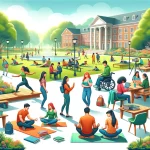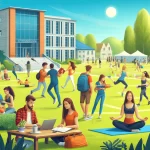What was it today? Another car accident, another train delay or another rainy walk? Or maybe the traffic was smooth, the station was calm and the world was abuzz with energy — but you still felt dreary and melancholic. What made today’s commute less than ideal? Although commuting maintains a healthy distance from any semblance of a fun and entertaining activity, commuters don’t have to slog through the doldrums each morning and evening. A commercial-free radio station, a good book or a simple change of mindset can turn around even the worst case of commuter blues.
Every year, the average by-car commuter spends 42 hours in traffic, costing $1,400 in gas, according to a study by driving-tests.org. Worse still, a study by the University of West England reports that adding just 20 minutes to a commute causes unhappiness equivalent to that felt by taking a 19% pay cut. People with long commutes also tend to be less physically active, leading to serious health issues such as obesity and high blood pressure, and have higher divorce rates than those with shorter commutes.
The natural assumption might be to place blame on the commute itself — insinuating that its mere existence is the issue. But such thinking resigns commuters to a hellscape twice a day with no hope of salvation. Whether commuting by car, train or on foot, there is a Virgil ready to lead every Dante-esque commuter through the modern-day “Purgatorio.”
First
Perhaps the most important, avoid detaching one’s own commute from that of others. People are skilled at orchestrating “me against the world” situations in which their own needs and wants become far more superior, far more urgent than those of others. Instead of empathizing with fellow commuters, one villainizes everyone else, leading to increased agitation and frustration.
Of Americans who commute to work, 76.4% drive alone, 9% carpool, 5% use public transport and 3% walk. Although these numbers vary by city, with densely populated college towns having more walkers and metropolitan areas having more public transporters, what does not vary is that all these people are commuting every day, twice a day.
So, take a breath, and remember everyone else is commuting too. They are sitting in the same traffic, waiting for the same train and walking through the same thunderstorm. They are also late for the morning meeting or simply trying to make it home for dinner. Be kind, be courteous and be understanding. Follow the “High School Musical” mantra: “We’re all in this together.”
Second
Remember that, although everyone commutes, someone has it worse. Namely, the ever growing “super commuters.” Super commuters are those commuting 90 minutes or more to work each day, usually via public transportation. One in 36 commuters, around 4 million people, qualify as super commuters, and the trend is growing. According to a 2018 study, the number of people super commuting increased from 2.4% in 2008 to 2.8% in 2016.
Danny Finlay, a 30-year-old living in Dixon, California, travels four hours (140 miles) every day to work as a PR representative in San Francisco. Finlay’s super commuter status is by choice — the cost of living in Dixon is so much cheaper that he estimates he saves $15,000 to $18,000 every year by not living in San Francisco itself. Others are not so lucky. They are forced to travel long distances due to job scarcity near their homes, and they are financially unable to relocate.
The likelihood of becoming a super commuter also depends on location. In Palmdale, California, 35% of commuters travel over two hours round-trip, in New York City its 26.1% and in Jersey City its 18.7%.
Third
Learn to make the best of your commuting time. For many drivers, the commute is unpleasant not so much because of road congestion, but because of the opportunity cost — the activities they could be doing instead of sitting in traffic. Obviously, one cannot clean the kitchen or write an essay in the car, but there are other ways to make the drive productive.
One common suggestion is listening to music, an audiobook or a podcast. But these can become background noise — the soundtrack of commuter blues. A commuter must fully engage in their chosen activity to truly chase away melancholia. Pick an album that pumps you up, a favorite band or radio station that produces a euphoria even the worst traffic cannot ruin. If commuting interrupts morning news watching, then flip on the AM radio or choose a news podcast (think “The Daily” or “Up First”). If study hours are being wasted, choose a textbook with audio-read options or playback a recording of recited vocabulary words.
When catching public transport, the above car-driving options still apply. Commuters additionally can take a book, schoolwork, business work or hobby activities like needlework. Fatigue may tempt one to simply nap on the train. But that not only leaves the commuter groggy upon reaching their destination, they also turned what could have been a productive train ride into wasted time. So better just caffeinate, power through and own the daily commute.
Finally, the walkers. In the world of unlimited 3G, offline downloads and pocket sized computers, walkers can listen to lectures, podcasts or audiobooks. They can catch up on YouTube videos, Facebook drama and the newest season of their favorite show. But, although valid options, the best and most productive option is to just unplug.
During lunch breaks and evenings before bed, most people unwind by falling into a world of screens and wires. Plugging in and zoning out are already regularly scheduled parts of the day, so adding even more is unnecessarily indulgent. When walking to work or school, take a moment and get lost in a different world. Whether that world consists of trees, grass and birds or skyscrapers, cafés and streetlights, learn to embrace it. Come rain, snow or heat, commuters will find focusing on these details to be meditative and calming — making the walk leisurely rather than breathlessly hurried.
Many people get so caught up in the act of commuting, coming and going, that they forget a commute does not have to be a state in between work and home. They can be productive periods of time in themselves if commuters find the motivation and embrace such a mindset. With the number of commuters, and length of commutes, increasing in the U.S. every year, more Americans will face commuter blues, making it essential everyone works to make an unavoidable daily activity more enjoyable.
















